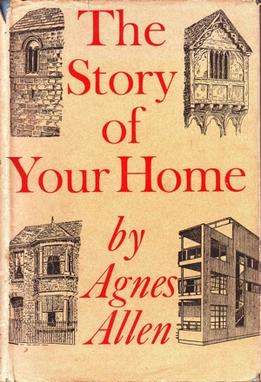The Story of Your Home facts for kids

Front cover of first edition
|
|
| Author | Agnes Allen |
|---|---|
| Illustrator | Agnes and Jack Allen |
| Country | United Kingdom |
| Language | English |
| Series | The Story of ... |
| Subject | Housing in Britain from prehistory to present, Architecture |
| Publisher | Faber and Faber |
|
Publication date
|
1949 1972, New edition |
| Media type | Print (hardcover) |
| Pages | 184 pp (first edition) |
| ISBN | 0571047181 (1972) |
| OCLC | 1122863 |
| 301.5/4/0942 | |
| LC Class | GT285 .A79 1972 |
The Story of Your Home is a non-fiction book for kids. It teaches about homes and how people lived in Great Britain. The book covers everything from ancient cave homes to modern apartment buildings. Agnes Allen wrote the book, and she also drew the pictures with her husband, Jack. Faber published it in 1949. Agnes Allen won the Carnegie Medal for this book. This award is given to the best children's book by a British author each year.
The Story of Your Home was part of a series of books. These books followed The Story of the Village, which Agnes Allen wrote in 1947.
How the Book Started
Agnes Allen got the idea for The Story of Your Home in 1943. She was living in an Oxfordshire village with her young son. He was very curious about the old Elizabethan houses there. Agnes realized that many children today live in modern homes. They just turn a tap for water or flip a switch for light.
She wanted to show them how homes used to be. In the past, people had to make almost everything themselves. This included building their own houses. So, she decided to write a book for children. It would describe the everyday homes of regular people throughout history.
This book came out when many non-fiction book series were popular. Publishers often created these series for schools and libraries. Books about British history were especially popular after World War II. They helped people think about rebuilding the country. The book's cover even said it was great for schools. It could be used for history or social studies classes.
Agnes Allen's "Story" series began with The Story of the Village in 1947. She wrote other books in this series too. These books were mostly about social history and art. Some titles included The Story of Our Parliament (1949) and The Story of Clothes (1955).
What's Inside the Book
The Story of Your Home is written for children in Britain. It uses only examples of buildings and old sites from Britain and Ireland. The book looks at homes where ordinary people lived. It also shows grand castles and large houses. It talks about more than just buildings.
The book also covers furniture, crafts, and how villages and towns were set up. It even explains how people lived their daily lives. You can learn about how roofs and windows changed over time. It also shares the origins of old sayings. For example, it explains ""by hook or by crook"" and "humble pie". The book also tells the story of how firefighting improved.
The earliest homes mentioned are Pin Hole in Derbyshire and Kent's Cavern near Torquay. These are described as the first human homes we know about in the country. Other chapters describe homes from different times. These include Iron Age roundhouses and mediaeval manors. You'll also see Tudor mansions and later country houses. The book brings you up to modern times with blocks of flats and suburban homes.
Chapters
- The Very First Homes
- Man Makes Himself a House
- The House Changes Its Shape
- How the House Developed
- The Manor House
- The Town House in the Middle Ages
- Life in the Castle and the Great House
- More about the Way Medieval People Lived
- Sixteenth-century Mansions
- Secret Hiding-Places
- Smaller Houses in the Sixteenth Century
- Seventeenth- and Eighteenth-Century Houses
- Inside the New Houses
- The Home Great-Grandmamma Lived In
- Homes of To-Day
Illustrations
The Story of Your Home has over one hundred black-and-white pictures. These include floor plans of some buildings. Agnes Allen and her husband, Jack, worked together on the illustrations. They are mostly simple drawings of typical homes, both inside and out. These pictures help you understand the text better. They are a very important part of the book. There are also some creative pictures that show what earlier times might have looked like. For example, there's a drawing of a prehistoric lake village.

